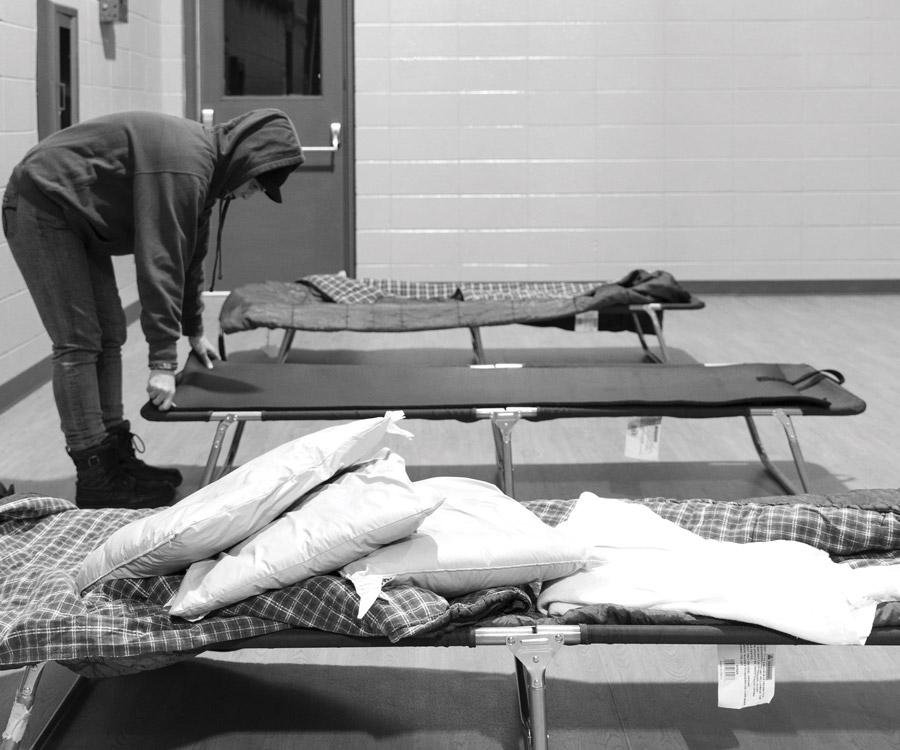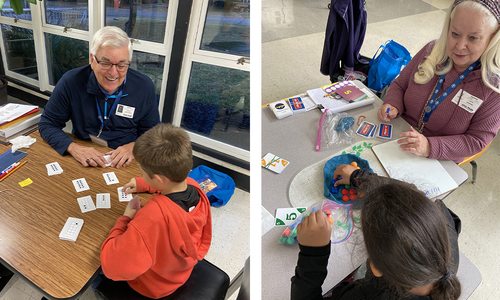Life
Taking A Long, Hard Look at Springfield's Poverty Problem
The fight against poverty in Springfield will be a long one, and we need your help. Dive in with the first article in our multi-part poverty series.
By Ettie Berneking | Photos by Chuck Travers
Jan 2015

If you want to find the face of poverty in Springfield, you don’t have to look too far. Look at the homeless who frequent downtown street corners. Look at the number of Springfield Public School students who receive free or reduced lunches each day. Stop by Rare Breed Youth Services one day, and meet the throng of teens who find refuge there—and a way to get themselves off the city’s streets. Just look around, and you’ll see poverty in Springfield.
The numbers are staggering. In 2000, the poverty rate in Greene County was 10.9 percent. By 2012, that number had jumped to 17.8 percent according to the U.S. Census Bureau. More than half of Springfield students qualify for free or reduced lunches. Over the last 15 years, that number has swollen from 33.6 percent to 54.6 percent.
It sounds daunting. But what’s even more worrisome is that if we as a community don’t do something to change the rising tide of poverty, it will get worse. But there’s hope, and you can be one of the people who ushers it in.

Breaking the Cycle
Meet Mary Johnson. With a surprisingly optimistic attitude and a bubbly personality, Johnson is a beacon of light in Springfield’s dark story of poverty. Despite the fact that Johnson is still out of work and struggling with debilitating health issues, she’s off the streets and out of the shelters thanks to the volunteers and civic organizations that serve as Johnson’s support network.
Due to health issues that have plagued her her whole life, Johnson spends most of her time at her one-bedroom apartment. The apartment and furniture inside are all paid for through The Kitchen Inc. Johnson has lived here for two years, but before getting her own place, she bounced around a maze of shelters.
Johnson went to her first shelter when she was 35. She’s now 48 and has five kids ages 15, 17, 26, 27 and 31. She had her oldest child when she was just 16 years old. Johnson’s youngest two were taken into foster care five years ago.
But it wasn’t always like this. Johnson comes from a good family in Milwaukee. Her mom was a nurse, and her dad was in the military. But life at home wasn’t always good.
“Losing everything taught me that you’re no better than the person next to you.”—Mary Johnson
“I was a daddy’s girl,” she says with a smile. But as she starts talking about her relationship with her mom, who passed away a few years ago, Johnson’s smile fades. “My mom had her picks,” she says. “And I wasn’t one of her picks.”
After having her first child at 16, Johnson’s health issues kept her out of work. She survived for years on social security. Life was good until the checks stopped coming, and the money dried up. “Losing everything taught me that you’re no better than the person next to you,” she says.
With no job and a troubled relationship with her family, Johnson and the kids jumped around the country—hitching rides with friends or riding on a Greyhound bus. Stops along the way included Knoxville, Tennessee, Nashville, Tennessee and South Dakota. She eventually decided it was time to find a home in a smaller town. “I didn’t want to live in a big city anymore,” she says. “You have to be too aggressive to get what you need. So I pointed blindly at a map, and my finger landed on Springfield.” Just like that, Johnson and her two young boys were headed to Missouri.
But life in Springfield wasn’t much easier. Living on the north side of town, Johnson was surrounded by poverty, and things looked bleak. “I think people on the south side see the problem but choose to ignore it,” she says. “When I first moved here, I noticed that the north is poorer than the south, but that’s true everywhere else I’ve lived. The north people always complain about the people on the south.”
Johnson and her kids eventually wound up at The Missouri Hotel. “It was rough,” she says. “It was me and my two boys. They were 3 and 4 at the time. It was pretty hard. My youngest got sick, and I missed two mandatory classes to be with him during the day.” As a result of missing the mandatory classes, Johnson and her two sons were kicked out of the hotel.
Eventually, the boys were taken into foster care. Johnson still calls them to check in. She worries about her oldest, who has anger issues and who, she believes, is autistic.
The likelihood that children who grow up in poverty will remain in poverty is high. It’s referred to as generational poverty, and it’s one of the main concerns surrounding poverty in Springfield. “The kids in generational poverty are the hardest to change,” says Loni Brewer, director of Rare Breed Youth Services, a drop-in center downtown that provides shelter and services to homeless and at-risk youth.
When Brewer started working at Rare Breed, the shelter was welcoming in 30 to 40 kids each night. That number has nearly doubled to an average of 80 kids per night. Not everyone is homeless. Some are between housing, and some just lack a stable family unit. These are situations Brewer knows first-hand.
Until she was 13 years old, Brewer and her younger sister often had to fend for themselves. “Both of my parents were loving when sober,” she says. “But drunk, my dad was Jekyll and Hyde.” Brewer’s dad was a deacon in the church, but at home, he’d burst into booze-fueled rages and abuse their mom. “My mom really held it together until Dad went to prison,” Brewer says. “I was in kindergarten, and she started to self-medicate with alcohol.” Everyday basics like clean laundry and food were often rarities. “I remember coming home one day with my sister, and there was no food,” she says. “We took Saltines with chocolate syrup and heated them on the windowsill.”
In fifth grade, Brewer and her sister were sent to live with their aunt and uncle for a few months before returning home to their mom. By the time she was 13, Brewer and her sister had been sent to live with their aunt again. This time, the move was permanent. “That’s how we made it out,” Brewer says. “When people ask how do you break the cycle of poverty—all we knew was abuse and alcohol. My aunt got us out.”
Formerly bouncing from shelter to shelter, Springfield resident Mary Johnson currently lives in an apartment paid for by The Kitchen Inc. Johnson keeps in touch with past volunteers she has worked with; One particular volunteer meets with Mary each month to take her shopping for yarn so she can enjoy her favorite pastime: crocheting.
Loni Brewer is the director of Rare Breed Youth Services. When she started working at Rare Breed, the shelter welcomed 30 to 40 kids per night. Now it averages 80 per night.
Working Together
Stories like Johnson’s and Brewer’s aren’t unusual. Situational and generational poverty can be seen all around town and in every demographic. But the community of Springfield is working together to address the issue.
In 2013, the sixth edition of the Community Focus Report was released. The report is designed to be a livability barometer that identifies “red flag” issues in Springfield. Each year since it started, poverty has been on that list.
In February 2014, 12 community groups, including Care To Learn and Junior League of Springfield, pooled their resources to bring Ruby Payne to town. Author of the best-selling book A Framework for Understanding Poverty, Payne has presented her thoughts on addressing and combating poverty in all 50 states and 10 countries.
“We sent her the Community Focus Report and the Every Child Promise and copious amounts of info about Springfield,” says Susie Turner, the 2013–2014 president of Junior League of Springfield. For three days, Payne met community groups and city leaders, and at the end she presented a 5-year, 10-year and 20-year plan to address poverty in Springfield.
“If you look at this issue broadly, it’s tough,” Turner says. “It’s like an enormous ship. They’re difficult to turn, and you have to have enough momentum to get them to turn.” That 20-year road map Payne laid out is aimed at building community momentum. “Payne told us to have realistic expectations,” Turner says. “It’s going to take 20-some years before we see a change, which is really hard. That takes a solid strategic focus and really dedicated individuals to continue that energy for that length of time.”
Twenty years might seem like an eternity, but Springfield is already ahead of the game. “One of the key things Payne talked about was understanding our community,” Turner says. “She said we’ve already done a ton of work. We already have a collaborative effort between public and private groups. That pushes everything forward.”
More than a year ago Lydia Ross (middle) signed herself and several of her coworkers from Mercy Regional Business Office up to serve meals to kids at Rare Breed, a drop-in shelter downtown that provides shelter and services to homeless and at-risk youth. Ross also works with the youth, such as Josh Peacock and Cody Teen-Southard pictured here, and helps sort donated hats, gloves and scarves she collects for the organization.
Coming to the Table
To see an example of this collaborative effort, drop by one of the bi-monthly Impacting Poverty Commission meetings. The group discusses the issues related to poverty in Springfield and hashes out a game plan for addressing the problem. The room buzzes with discussion as faith-based leaders talk with private and public organizations, and members of the Springfield Area Chamber of Commerce brainstorm with city planners.
“It has been the most rewarding thing I have ever done. I am so much more blessed by the kids than they are by me.”—Lydia Ross
The question has become, how do you motivate people to action? Sitting in her small apartment that overlooks the whirl of traffic on Battlefield, Johnson’s not convinced that people really know the significance of the problem. “They see it, but they ignore it,” she says. “You can make a donation, but then it’s too easy to go back to your normal life.”
Where making a donation can keep you disconnected from the reality of poverty, finding the time to volunteer can put you in touch with the people who need your help the most. Lydia Ross and several of her coworkers from Mercy Regional Business Office have been serving meals to the kids at Rare Breed once a month for about a year. The group was looking for a way to help out in the community, and when they learned that Rare Breed was in need of volunteers to help serve dinner, Ross signed everyone up. “It has been the most rewarding thing I have ever done,” Ross says. “I am so much more blessed by the kids than they are by me.”
Getting residents engaged is no small task. Mike Stout, associate professor of sociology and anthropology at Missouri State University, knows first-hand the difficulty of prompting action both from those living in poverty and those with the resources to help address the problem.
“Just by looking at the family and neighborhood you’re born into, we can predict where you’ll end up on the socioeconomic scale. That’s not what the American dream is all about.” —Mike Stout
Stout is one of many members on the Impacting Poverty Commission, and he serves as the director of Missouri State’s Center for Community Engagement. His expertise on how to best mobilize the community landed him a seat at the table. But according to Stout, there’s one seat that’s still sorely missing. “We need to have this conversation with our elected officials,” he says. “We need a lot of resources from state and federal governments, but we can’t get that money unless we bring the politicians to the table.”
When the economic recession hit in 2008, social welfare programs across the board were cut, and Rare Breed lost a significant chunk of its funding.
It’s these sorts of problems that get Stout revved up. Low-paying jobs and limited access to childcare and early childhood education are factors that play into the reality of poverty. “We need to level the playing field, so every kid has the same chance to succeed in life,” Stout says. “Just by looking at the family and neighborhood you’re born into, we can predict where you’ll end up on the socioeconomic scale. That’s not what the American dream is all about.”
Last year, one of Stout’s major projects was completing a report called “The Cost of Doing Nothing.” By compiling both local and state data, Stout was able to calculate the actual cost of not addressing poverty. “There were 4,837 children in Greene County living below the poverty line in 2012,” he says. “That’s 28 percent. So I looked at the data to show what we’re already spending on intervention care per child in the areas of child abuse and neglect, childhood obesity and food insecurity. Then I looked at what we would end up spending on that child over the course of their life. Out of those numbers, the most expensive was child abuse and neglect. The second was hunger.”
So what do you do to combat this issue? Where do you start? For Stout, the answer is two-fold: Offer better paying jobs, and offer high-quality early childhood education.
But if you ask Johnson what she would do first, she has a different answer. “We need to create a place for these [homeless] women to go during the day where they can learn skills that will keep them from having to go back to the shelter,” she says.
Living on the streets for so many years, Johnson and the other women she met spent most of their days hanging out at the Midtown Carnegie Branch Library. They had to be packed up and out the door at 7 a.m. when the shelters closed, and they couldn’t return until 7 that night. “That’s 12 hours out on the streets,” Johnson says. “It didn’t matter if it was raining or snowing.” But at night, the group had shelter, and they had each other. Johnson loves listening to people’s stories. She would spend most of her evenings at the shelter talking with other women and learning what had brought them there. “These are my girls!” she says laughing. “You laugh with them, and you cry with them.”
By listening to others who were walking in the same shoes as herself, Johnson was able to navigate the maze of shelters and food pantries. Eventually, she was directed to Safe To Sleep, where she met Romona Baker. Baker has been volunteering for years. She’s retired, but her civic work is a full-time job. Each night, the Safe to Sleep shelter welcomes an average of 25 women. Exhausted and beaten down, Johnson remembers nights when she was too worn out to even pull her cot out on the floor to sleep. Baker and other volunteers at the shelter were there to help. They were the lifeline she needed to get out of the cycle of homelessness.
Mike Stout, director of Missouri State University’s Center for Community Engagement, is one of many members on Springfield’s Impacting Poverty Commission.
Moving Forward
Thanks to programs like Safe To Sleep and The Kitchen Inc, Johnson is now off the streets. She has groceries in the fridge and access to healthcare. Right now, Johnson is catching up on her health issues, but then she’s ready to start looking for work. Her dream job is at Hobby Lobby just down the road.
But for every story of success, like Brewer’s, there are dozens of homeless and at-risk families still in need of help. Carrying out Ruby Payne’s 20-year plan Ruby Payne is key to addressing this issue, and the Impacting Poverty Commission is chewing on what steps to take next. But they can’t do it alone.
Poverty in Springfield is an issue that we’ll revisit throughout the year, as we take a deeper look at some of the specific areas where Springfield has a need, and you can lend a helping hand. Check back in April as we continue the discussion. Because no matter how daunting the numbers might be, there is hope.
A volunteer for many years, Romona Baker helps many homeless women stay in a safe, stable environment overnight at the Safe to Sleep shelter.

Designed to show the real-life challenges of a low-income life, the poverty simulations at OACAC are an eye-opening experience.

The entire 417 Magazine staff participated in an OACAC poverty simulation.
We’d known for weeks that a poverty simulation at Ozarks Area Community Action Corporation (OACAC) was in our future. The 417 Magazine staff was meeting at OACAC’s main office to experience the simulation together. And even though we’d been told that we’d face many real-life challenges over the course of a two-hour period, we had no idea just how hard it would be to step into the lives of people living in poverty.
During the simulation, participants are assigned the role of a low-income family member, each with his or her own story. In each of four 15-minute “weeks,” participants have to face real-life situations while trying to pay their bills and put food on the table. They must try to survive.
I played the part of a 34-year-old mother of two teenagers. Her husband had just left her with $10, no job and no money in the bank. She had no car.
The odds were stacked against my little family, but we made a plan. First I was going to use our only money to buy transportation passes (which you had to have to do anything else), then I would sign us up for some services to help us pay for groceries and other immediate needs. Next, I’d work to find a job.
Immediately I realized that a good plan doesn’t mean anything when you have so many hurdles and so few resources. Nothing went as planned. When the first week ended, we had no food on the table and no money. I wasn’t able to line up a job, so by the end of the second week, our utilities had been turned off. Eventually, we were evicted.
While we began with a plan and plenty of hope, we ended feeling defeated and hopeless. It was hard, very hard. The experience was profound, and it only touched on the reality of people living in poverty and doing these things every single day.—Katie Pollock Estes
To schedule a poverty simulation for your group, contact OACAC at 417-873-3372.












.jpg)



